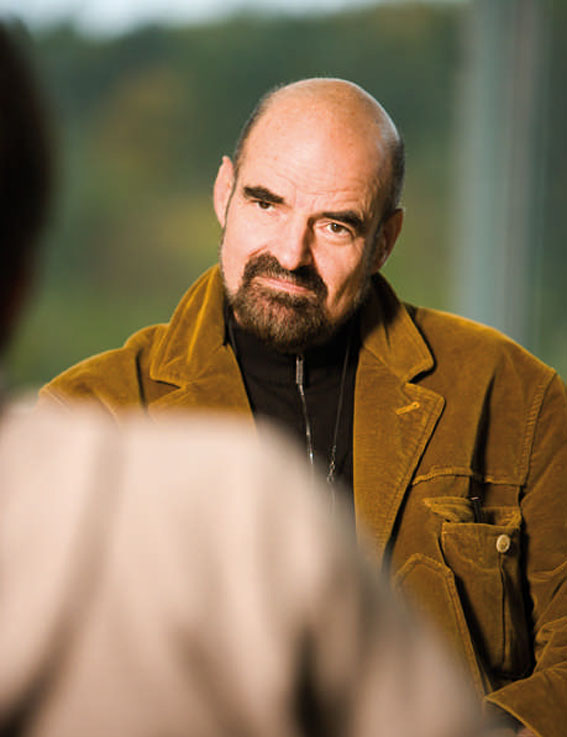"BlitzDefence" – Interview instead of editorial – part 3
 We wanted to talk about your "BlitzDefence" method. How did the idea come about?
We wanted to talk about your "BlitzDefence" method. How did the idea come about?
Anybody who has practiced WT for many years should have developed sufficient means of self-defence. Things are quite different for those …
 |
| Markus Senft interviewed GM Kernspecht for WTW online |
… who have perhaps only been training for a few months. Yet it is precisely those who have a need for security. The same is true of security personnel, police officers etc., who are allowed only a few hours of training.
Before the creation of BlitzDefence, clients such as these were obliged to fire off salvos of chain-punches at anybody who stood in their path, is that right?
Right, and they can continue to fall back on this "straight blast" if, against expectation, the more reasonable means offered by BlitzDefence should fail to do the trick. I developed BlitzDefence at the end of the 1990s. It is made up of body language, verbal communication, automatic responses and an appropriate forward defence which proceeds responsibly and more commensurately, and in the ideal case consists of a single knockout blow should all attempts at de-escalation prove unsuccessful.
What was the problem with the chain-punches?
The frequently lacking proportionality that western courts of law expect. Somebody who has overwhelmed another with 30 chain-punches just because he had the "impression" that he was about to be attacked will find little understanding in front of a judge.
I know the answer, but will ask anyway for the benefit of laymen: why do we have to strike anyway? Is it not better just to take avoiding action and apply a lock to calm the other party down?
That would certainly be more humane. However this capability is only achieved after several years. An innocent party who has not provoked an attack cannot be expected to take such a risk. Moreover, we have found that a beginner has the best chances if he launches his own surprise attack.
How can the beginner bring himself from the correct decision – that he has to attack to have a chance – to the action of delivering a blow that eliminates the threat?
For example by using the "trigger-word", an idea for which I am grateful to my friend Geoff Thompson in England. It takes you from the decision to decisive action.
BlitzDefence has been around for quite a while now. How effective has it proved to be?
We can look back on 13 years of experience in private and official use in many countries of the world. It has more than proved its worth. In the roughest cities and in crisis areas. Corresponding reports and expressions of thanks have confirmed our expectations.
We have continuously developed it further on the basis of experience gained, by which I mean we have simplified it.
On what is BlitzDefence based in technical terms?
On a disguised, non-provocative safety position, applied psychology, attentiveness, determination, distraction and a punch behind which the bodyweight is concentrated.
Did you develop it all yourself?
I wish that were so. But I was able to fall back on the findings of many experts. For example Jesse Glover, Bruce Lee's 1st student and assistant instructor. Geoff Thompson, Europe's most famous doorman, Bill Newman, who needs no more introduction from me than my Chinese master Leung.
To what does the BlitzDefence user respond?
To a few visual patterns.
How many techniques must be learned for this?
I have managed to get by with fewer than six techniques (combinations). Any further movement would be one too many to learn. There is also a division of tasks: our dominant (stronger) hand delivers the knockout, the weaker controls the opponent.
Can we really call this true WingTsun? I mean WT as you understand it. After all, you teach a WT that emphasises attentiveness and is not based on routines or automatic responses.
The 6 techniques used are fundamentally from WT, as are the functional principles behind them. It is self-evident that BlitzDefence for beginners cannot be the high art of a philosophical, spontaneous and creative WT that uses presence of mind to create "instant concepts", as Prof. Tiwald calls them, and realises "movements of the moment". But neither are the blindly aggressive salvos of chain-punches of yesteryear the real WingTsun, where the preceding punch is the reason for the next and the function is overlooked. BlitzDefence is primarily about self-protection. A WT that meets the beginner's need for rapid security.
Is it primarily security that the new student is looking for when he comes to an EWTO school?
I think this is the prevailing motive for starting to learn WT. When this justified need is satisfied, there are other reasons to continue practicing WT.
What would these reasons be?
To learn an Asian movement art, a philosophy in motion, to express oneself and realise one's potential. Over and above pure self-defence, WT offers so many attractive possibilities.
Could one say that the real WT only begins after BlitzDefence?
Just as one might talk about the art of eating well, of enjoying and being a gourmet when it is no longer a matter of preventing starvation? Yes, perhaps.
BlitzDefence wants to be no more and no less than an applied, simplified WT for the beginner who seeks a fast route to self-defence.
BlitzDefence is just one of the teaching programmes that you have placed alongside the traditional programmes; shall we talk about your further innovations next time?
By all means!
The interview with Markus Senft will be continued in December …


